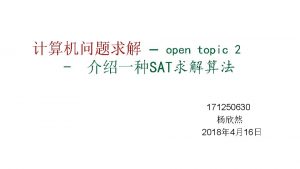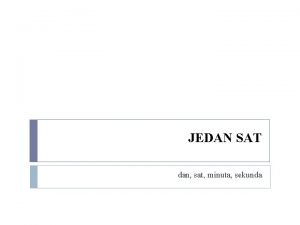Sat 28 March 2020 Week 8 Lecture 6





- Slides: 5

Sat. 28 March 2020. Week 8: Lecture 6 Faculty of Education Department of English Language & Literature Subject: Lecturer: Grade: Introduction to Linguistics Dr. Mariana Adel Sedki Third Year The 20 th. C Linguistics : Continued The Prague School (pp. 18, 71, 72, 73, 74, 75, 76)

Structuralism have gained wide recognition in Europe. Accordingly, many linguistic schools there promoted structuralism. The most important of the various schools of structural linguistics to be found in Europe in the first half of the 20 th century included the Prague school, most notably represented by Nikolay Sergeyevich Trubetskoy (died 1938) and Roman Jakobson (died 1982), the Copenhagen school, centered around Louis Hjelmslev (died 1965). John Rupert Firth (died 1960) and his followers, sometimes referred to as the London school, were less Saussurean in their approach, but, in a general sense of the term, their approach may also be described as structural linguistics.

The Prague school was a group of linguists who formed the Linguistic Circle of Prague in 1926. The primary interest of the Circle was in the phonological theory. Its most prominent figure was Nicholai Trubetzkoy whose book Principles of phonology made up important contributions to the notion of phoneme. Trubetzkoy & his followers defined phonemes as sets of distinctive features. They claimed that each sound in a language is made up of a number of articulatory features and is distinguished by the presence or absence of at least one feature from every other phoneme in a language. They called this phenomenon ‘’phonological opposition’’ that is a sound difference which results in a meaning difference.

For example, 'pit' and 'bit' mean different things and differ only in /p/ and /b/ as one is voiceless and the other is voiced. Thus, voicing is regarded as a distinctive feature in English. When two phonemes are distinguished by the presence or absence of a single distinctive feature, one of them is said to be marked and the other is unmarked for that feature. In the above example, /p/ is unmarked and /b/ is marked (regarding voicing). Another valuable contribution to this school of linguistics is in the field of syntax. Prague linguists are concerned with the ‘’order of ideas’’ in a sentence or an utterance. They refer to the arrangement of information within a sentence FSP (functional sentence perspective).

This theory describes the information structure of the sentence as it proceeds from the known information to the unknown information. The known or the given part of the sentence is called ‘’theme or topic’’. The unknown or the new part of the sentence is called ‘’rheme or comment’’. So the ‘’theme-rheme’’ sequence is considered unmarked word order. On the other hand, the ‘’rheme-theme’’ sequence is the marked word order. Markedness, here, is caused by the deviation from the natural grammatical word order. Good luck Dr. MARIANA ADEL SEDKI









